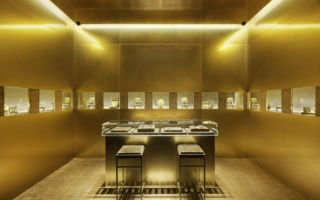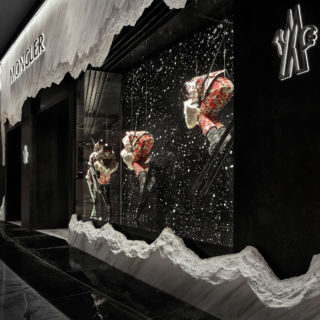Curiosity
2-13-16 Tomigaya Tokyo, Tokyo 151-0063 Japan
Born in France, Gwenael Nicolas studied interior design in Paris, and industrial design at the RCA in London, before heading for Japan to work as a freelance designer. From early on he had interesting clients, including Issey Miyake, for whom he created the ‘Pleats Please’ store concept.
Eight years after his arrival in Japan, he set up Curiosity with Reiko Miyamoto in 1998. The design studio works across a broad range of disciplines; from architecture to graphics, cosmetic packaging to product design, and furniture to interiors. Within retail interiors most of their work is with high-end fashion brands including Dolce & Gabbana, Fendi, Louis Vuitton, Shu Uemura and Maison Moynat.
The consultancy loves playing with light, exploring how it can be used to animate a space. This is clearly evident in Curiosity’s store design for D&G, in Tokyo’s wealthy district of Ayoama. Visually it’s a high contrast environment, with ceiling mounted projectors illuminating product. The lighting moves around the space, shifting the customer’s focus. As they stand in front of a product, lights come on and garments suddenly come to life in front of them. This concept closes the gap between the digital and physical world, as products pop up as they would when you browse a website, and as the lights turn on and off, they take you on a journey, helping you navigate the space.
With D&G’s quest to create localised destinations, Curiosity has created an opulent flagship for the brand in Milan. Housed in a 19th century palazzo, the rich use of green marble and elm burr plays to the baroque surroundings, whilst the linear design injects modernism. Once again lighting is key in providing focus on the product presented in store. There’s a museum-like quality about the space, that doesn’t negate from the concept, but creates a desire to explore and discover more. Their latest store for D&G on Old Bond Street is titled ‘The baroque poetry of nature’, the fully restored façade preserves the Baroque forms of the building’s heritage, while inside the powerful use of monochromatic marble, creates a most striking interior, cleverly pieced to carry customers from one space to another.
A sense of place is also achieved in Fendi’s Rome flagship – the spiritual home of the brand. The concept reflects the city and the grandeur of the 17th century building in which the store is housed. The monumental marble staircase is lined with amphi-theatre like alcoves, which morph from the stone walls. The design of each room and the merchandising fixtures and furniture are equally as beautiful as the product itself; not fighting for attention, but providing a backdrop that is fitting for the brand.
The first mono-brand store for Moncler located in the luxury shopping destination, Dubai Mall the concept embodies the heritage and contemporary qualities of the brand. Ultra high ceilings give the feel of walking through a forest, with the ever impeccable use of textures and detailing throughout, the boutique includes a contrasting light and padded fitting room, which mimics the lining of a Moncler down jacket!
We love their playful store for Chinese streetwear brand Hipanda in Tokyo, its immersive store concept combines digital and analogue features, bringing together architectural features with augmented reality (AR) technology, which comes to life in the ‘ghost house’.
Gwenael has an optimistic and fearless ‘can do’ attitude, which enables him to design concepts whose realisation is highly ambitious. Exciting for the client, but even more exciting for the customers that experience the stores that he designs.

















